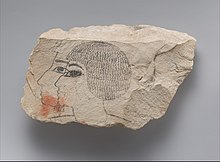| Ostracon of Senemut | |
|---|---|
 Limestone ostracon of Senenmut Limestone ostracon of Senenmut | |
| Material | Limestone |
| Height | 7.62 cm |
| Width | 17.78 cm |
| Created | c. 1469 BC |
| Discovered | Egypt |
| Present location | New York City, New York, United States |
The Ostracon of Senemut is an ancient Egyptian limestone ostracon which dates from the reign of Hatshepsut (1479 BC – 1458 BC), in the 18th Dynasty.
Design
The ostracon portrays Senemut, a courtier of Hatshepsut.
It is a figured-ostracon, of portrait type with heads only. The ceramic is made of white limestone, with dimensions of approximately 3 in (0.8 dm) by 7 in (1.8 dm).
The Ostracon of Senemut is currently part of the collection at the Metropolitan Museum of Art.
Traditionally, ostraca in Egypt were used for artist's sketchings, cartoons-caricatures, letter documents, school–practice writing, and graffiti.
Ostraca depicting Senenmut
-
 Ostracon found from the dump below Senenmut's tomb chapel (SAE 71) thought to depict his profile. Now in the Metropolitan Museum.
Ostracon found from the dump below Senenmut's tomb chapel (SAE 71) thought to depict his profile. Now in the Metropolitan Museum.
-
 Ostracon found from the dump below Senenmut's tomb chapel (SAE 71) thought to depict his profile. Now in the Metropolitan Museum.
Ostracon found from the dump below Senenmut's tomb chapel (SAE 71) thought to depict his profile. Now in the Metropolitan Museum.
See also
References
- "Artist's Sketches of Senenmut". metmuseum.org. Metropolitan Museum of Art. Retrieved 4 February 2020.
External links
- Picture of Ostracon of Senemut and Djehuty.
- Article discussion
- Metropolitan Museum of Art: official site
This article about subjects relating to ancient Egypt is a stub. You can help Misplaced Pages by expanding it. |